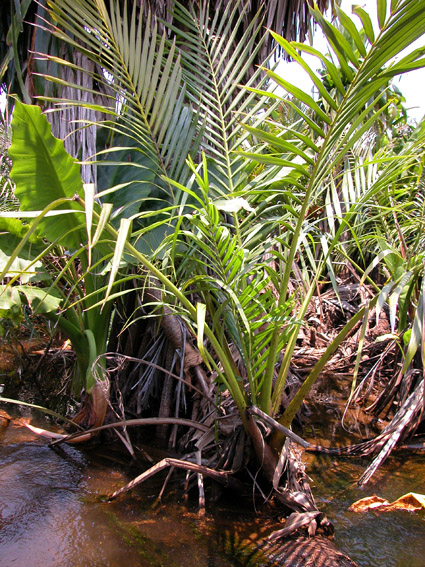- Acanthophoenix
- Acrocomia
- Actinokentia
- Actinorhytis
- Adonidia
- Aiphanes
- Allagoptera
- Ammandra
- Aphandra
- Archontophoenix
- Areca
- Arenga
- Asterogyne
- Astrocaryum
- Attalea
- Bactris
- Balaka
- Barcella
- Basselinia
- Beccariophoenix
- Bismarckia
- Borassodendron
- Borassus
- Brassiophoenix
- Burretiokentia
- Butia
- Calamus
- Calyptrocalyx
- Calyptrogyne
- Calyptronoma
- Carpentaria
- Carpoxylon
- Caryota
- Ceratolobus
- Ceroxylon
- Chamaedorea
- Chamaerops
- Chambeyronia
- Chelyocarpus
- Chuniophoenix
- Clinosperma
- Coccothrinax
- Cocos
- Corypha
- Cryosophila
- Cyphokentia
- Cyphophoenix
- Cyphosperma
- Daemonorops
- Deckenia
- Desmoncus
- Dictyocaryum
- Drymophloeus
- Elaeis
- Eleiodoxa
- Eremospatha
- Eugeissona
- Euterpe
- Gaussia
- Geonoma
- Guihaia
- Hedyscepe
- Hemithrinax
- Howea
- Hyophorbe
- Hyospathe
- Hyphaene
- Iriartea
- Iriartella
- Itaya
- Jailoloa
- Johannesteijsmannia
- Juania
- Jubaea
- Jubaeopsis
- Kentiopsis
- Kerriodoxa
- Korthalsia
- Laccospadix
- Laccosperma
- Lanonia
- Latania
- Lemurophoenix
- Leopoldinia
- Lepidocaryum
- Lepidorrhachis
- Leucothrinax
- Licuala
- Linospadix
- Livistona
- Lodoicea
- Lytocaryum
- Manicaria
- Manjekia
- Marojejya
- Masoala
- Mauritia
- Mauritiella
- Maxburretia
- Medemia
- Metroxylon
- Myrialepis
- Nannorrhops
- Nenga
- Neonicholsonia
- Neoveitchia
- Nephrosperma
- Normanbya
- Nypa
- Oenocarpus
- Oncocalamus
- Oncosperma
- Orania
- Oraniopsis
- Parajubaea
- Pelagodoxa
- Phoenicophorium
- Phoenix
- Pholidocarpus
- Pholidostachys
- Physokentia
- Phytelephas
- Pigafetta
- Pinanga
- Plectocomia
- Plectocomiopsis
- Podococcus
- Pogonotium
- Ponapea
- Prestoea
- Pseudophoenix
- Ptychococcus
- Ptychosperma
- Raphia
- Ravenea
- Reinhardtia
- Retispatha
- Rhapidophyllum
- Rhapis
- Rhopalostylis
- Roscheria
- Roystonea
- Sabal
- Sabinaria
- Salacca
- Saribus
- Satakentia
- Satranala
- Schippia
- Sclerosperma
- Socratea
- Solfia
- Sommieria
- Syagrus
- Synechanthus
- Tahina
- Tectiphiala
- Thrinax
- Trachycarpus
- Trithrinax
- Veitchia
- Verschaffeltia
- Voanioala
- Wallaceodoxa
- Wallichia
- Welfia
- Wendlandiella
- Wettinia
- Wodyetia
- Zombia
- x Jubautia splendens
- ?? Acoelorrhaphe
- ?? Bentinckia
- ?? Brahea
- ?? Clinostigma
- ?? Colpothrinax
- ?? Copernicia
- ?? Cyrtostachys
- ?? Dictyosperma
- ?? Dransfieldia
- ?? Heterospathe
- ?? Hydriastele
- ?? Iguanura
- ?? Incertae sedis & excluded names
- ?? Loxococcus
- ?? Micronoma
- ?? Paripon
- ?? Pritchardia
- ?? Rhopaloblaste
- ?? Serenoa
- ?? Washingtonia

Introduction
- Insufficiently known species. This species is known from a single incomplete specimen. The collector described it as growing beside a river and in the water. The inflorescence seems to have a long peduncle and is somewhat reminiscent of those of members of the "Vonitra" group. We are tempted to suggest that this is a stemless rheophyte and those with a mind to try to refind it should perhaps look for a palm with a habit reminiscent of Chamaedorea cataractarum. (Dransfield, J. & Beentje, H. 1995: The Palms of Madagascar)A
Distribution
Manantenina. (Dransfield, J. & Beentje, H. 1995: The Palms of Madagascar)A
Discussion
- Distinct from all other species in the "Vonitra" group by the leaves with scattered scales and much ramenta, as well as by their small size. (Dransfield, J. & Beentje, H. 1995: The Palms of Madagascar)A
Diagnosis
- Palma acaulescens verosimiliter rheophytica D. fibrosae affinis folio pinnata pinnis squamas dispersas ramentas ferentibus inflorescentia pedunculo longo terete in 2 ordines ramificanti distincta. (Dransfield, J. & Beentje, H. 1995: The Palms of Madagascar)A
Biology And Ecology
- "Riverside and in the water" (Guillaumet). (Dransfield, J. & Beentje, H. 1995: The Palms of Madagascar)A
Conservation
- Uncertain. Probably Endan gered, since it seems to be restricted to a single area. (Dransfield, J. & Beentje, H. 1995: The Palms of Madagascar)A
Uses
- Not recorded. (Dransfield, J. & Beentje, H. 1995: The Palms of Madagascar)A
Description
- Trunk very short, if not non-existant (Guillaumet). LEAVES: sheath unknown; petiole part on type 25 cm long, proximally 2 cm diam., deeply channelled, rapidly tapering to the distal diam. 0.8 cm and slightly channelled; rachis c. 8 mm diam. in upper/mid-leaf; leaflets regular, close, the median 21-23.5 x 1.2-1.3 cm, the distal 10-18 x 0.4-1.1 cm, main vein 1, apices unequally acute, indument: adaxial midrib as well as margins with small dark ramenta, abaxial minor veins with dense but scattered minute scales. INFLORESCENCE branched to 2 orders; peduncle at least 21.5 cm and probably considerably longer, 5 x 3 mm diam., glabrous; bracts at least 3 major ones, opening near the apex only, the most distal tubu lar bract 5.5 cm long; non-tubular peduncular bract c. 1 cm long; rachis (one seen) 27.5 cm long, with 12 branches, the proximal 4 or 5 bifurcate; rachis bracts proximally c. 5 mm long; rachillae 17-24 cm long, 1.5 mm diam., glabrous, with spaced triads. STAMINATE FLOWERS with sepals 1.5-1.8 x 1-2 mm; petals 1.8-2.4 x 1.6-1.7 mm, acute to obtuse; stamens 6, didymous, uniseriate, the filaments 1-1.4 x 0.5-0.6 mm, flat and slightly triangular, anthers 0.4-0.5 mm high, 0.7-0.8 mm wide, dorsifixed; pistillode 1.7-2 x 0.8 mm. PISTILLATE FLOWERS unknown. FRUIT unknown. (Dransfield, J. & Beentje, H. 1995: The Palms of Madagascar)A
Materials Examined
- Tolanaro: Manantenina, Dec. 1971 (fl.), Guillaumet 4003a (P). (Dransfield, J. & Beentje, H. 1995: The Palms of Madagascar)A
- Log in to post comments

